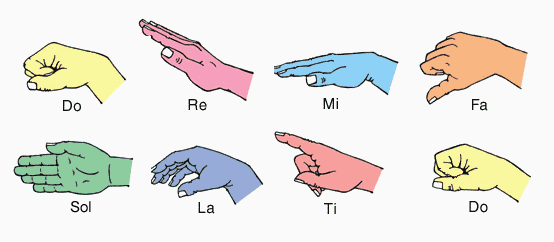The solfege system as we know it dates all the way back to the 1800’s, and makes its way into many different methods of teaching singing and aural skills. One of the most popular and well-known music teaching methodologies is the Kodaly Method, developed in the mid-twentieth century by Hungarian composer and music teacher Zoltan Kodaly. The Kodaly Method involves many different educational aims and subjects, and was primarily designed to make music education in Hungary’s elementary schools more effective.
Kodaly borrowed many of his ideas about teaching music from other pedagogues, including theorists in Britain and Switzerland. One theorist in particular, Englishman John Curwen, gave Kodaly his ideas about solfege. The Kodaly method uses movable-do solfege, which we’ve discussed before, and adds one fantastic tool to the system: the solfege hand signs.
The solfege hand signs (also called the Kodaly hand signs or the Curwen hand signs) were originally developed by John Curwen, but popularized through their use in the Kodaly method. The idea behind the solfege hand signs is simple: each tone of the seven-note solfege system is given a shape for the singer to make with his/her hand while singing. All of the hand signs can be produced using one hand, and can be helpful for singers who are new to the solfege system.
Using the solfege hand signs simply requires keeping one hand free while singing; whichever one you like is fine. Begin with your hand at about the level of your sternum, and make the following shapes as you sing each note of the major scale:
Do – Make a fist with your palm facing down.
Re – Straighten your fingers (keeping them together), and bring your hand up to make a 45-degree angle with the ground.
Mi – Keep the same hand shape, but move your hand so that it is parallel with the ground.
Fa – Making a loose fist with four fingers (palm facing downward), extend your thumb and point it downward, almost perpendicular with the rest of the hand.
Sol – Straighten the fingers so that the hand has the same shape as in mi, but tilt it so that your palm is directly facing you.
La – Curve the hand gently, with the palm and fingertips facing the floor.
Ti – Make a loose fist, but point the index finger upward at about a 45-degree angle with the ceiling.
…and back to Do!
The Kodaly method uses these solfege hand signs for a few important reasons, but for novice singers they can simply be helpful in learning the basics of solfege. Later on, when we look at note tendencies and resolutions, we’ll examine why each note’s solfege hand sign looks the way it does. For now, the easiest way to learn them is to just practice! Start with simple up-and-down scales (do to do) and three-note arpeggios (do-mi-sol-mi-do, re-fa-la-fa-re, etc.).
Ready to start learning?
Join 13,500+ happy users today!
We offer a 14-day money back guarantee, so purchasing is risk-free!

